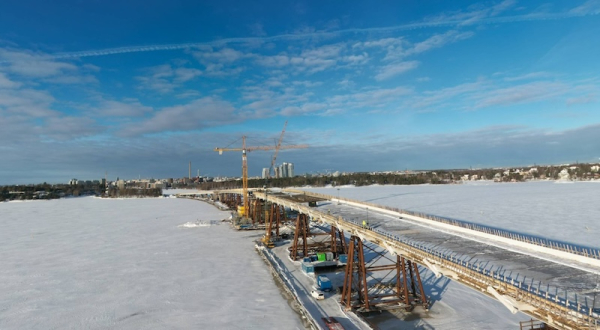
The construction of the pylon is underway at the tower crane’s location. The height of the tower crane in the picture is about 60 meters. The pylon will be 135 meters high. Photo: HTJ/Kruunusillat Tramway
- Previous Article Enhanced aurora borealis forecasting service promises greater precision
- Next Article Over 1,900 vocational students to compete in Taitaja2024 semifinals across Finland
Helsinki is set to witness the rise of a new architectural marvel as the central support pylon of the Kruunuvuorensilta (Crown Bridge) is expected to soar above 100 meters this year. Once completed, the pinnacle of the pylon will reach an impressive height of 135 meters above sea level, becoming a significant landmark in the city’s skyline.
Currently, the pylon has reached the bridge deck level, standing approximately 20 meters above sea level.
The structure, which is the most prominent among the bridge’s support elements, anchors 17 pairs of diagonal cables on both sides. Including the subsea structure, the total height of the pylon, from the base plate to its top, is around 145 meters.
The construction of the pylon utilizes the ‘climbing formwork’ technique for the parts above the deck level. After each segment of concrete is poured and allowed to set to a specific strength, the formwork is detached and ‘climbed’ upwards for the next phase of construction. This process includes the simultaneous ascent of the maintenance platform surrounding the pylon structure.
The pylon will undergo approximately fifty concrete pours before reaching its final height. So far, eight pours have been completed, with the next scheduled for February. The pylon’s reinforcement has been uniquely designed using high-strength SAS bars (50 mm in diameter) alongside conventional steel reinforcement.
Foundational Structure of the Pylon
The pylon is founded directly on bedrock, with the lower foundation level sitting 9.5 meters below sea level. The lower base plate, measuring 18 x 18 x 4.5 meters, was cast over a bedrock-excavated pit. This base supports a slightly smaller upper base plate. While the lower plate was constructed underwater, subsequent structures are built using dry construction methods. The pylon’s base starts from these foundation plates.
The pylon comprises several parts: the foundation, base, connecting beam, lower and upper sections of the pylon, the cable area, and the pinnacle. The base extends from below sea level to a height of 19.5 meters and is a solid reinforced concrete structure.
The connecting beam, spanning from 19 to 25 meters in height, links the bridge’s steel structure with the pylon. The pylon’s lower section extends from 25 to 78 meters in height and consists of two hollow legs, one housing a service stairway and the other a service elevator reaching up to 98 meters. The upper section of the pylon begins at 78 meters and extends to 101 meters, where the legs rejoin into a single structure. The cable area spans from 101 to 124 meters in height.
From the cable level to the top, three more pouring phases will be completed to reach the final height of 135 meters. The pinnacle features a balcony for maintenance, including aviation obstruction lights, and will be fitted with a lightning rod for protection.
The completion of the pylon is scheduled for 2025, and passenger traffic on the new tramway across the bridge is expected to commence in 2027. This ambitious project not only signifies Helsinki’s commitment to modern infrastructure but also adds a striking new element to the city’s architectural landscape.
HT
- Previous Article Enhanced aurora borealis forecasting service promises greater precision
- Next Article Over 1,900 vocational students to compete in Taitaja2024 semifinals across Finland
Source: www.helsinkitimes.fi
